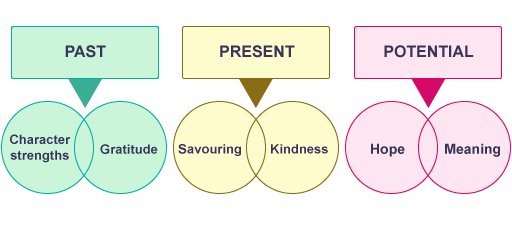1.2 What you can expect from the course
The video in section 1.1 highlighted that positive psychology has identified ways to boost happiness and wellbeing.
Throughout the rest of this course, you will be introduced to some of the ways you can boost your happiness and wellbeing, and that of your children, using six key themes that have been shown to improve wellbeing through the way we think about the past, present and future potential.
These six themes are illustrated in the diagram below.
For each of the themes introduced in the course, you are shown some practical activities that you can try at home. The benefits of these have all been supported scientifically and can be attempted by yourself during the course. They can also be adapted to work with children of all ages within the home. Being a good role model to our children is also a great way to help enhance their wellbeing.
Using these techniques can help you focus on improving relationships within the family and having a more optimistic outlook when imagining the future. It can also help you to build on your personal resilience and have a clearer sense of your purpose and meaning in life (Lyubomirsky, 2006).
It is strongly recommended that you have a notepad or a journal to hand during the period that you take this course. You may find it very helpful to reflect on how you have found certain activities and you may want to take notes about ideas and resources that you can use in the future.
We hope you find the course interesting and that you are inspired to try some of the practical ways to boost happiness and wellbeing in your home.
1.1 What is positive psychology and how can it help with wellbeing in the home?

